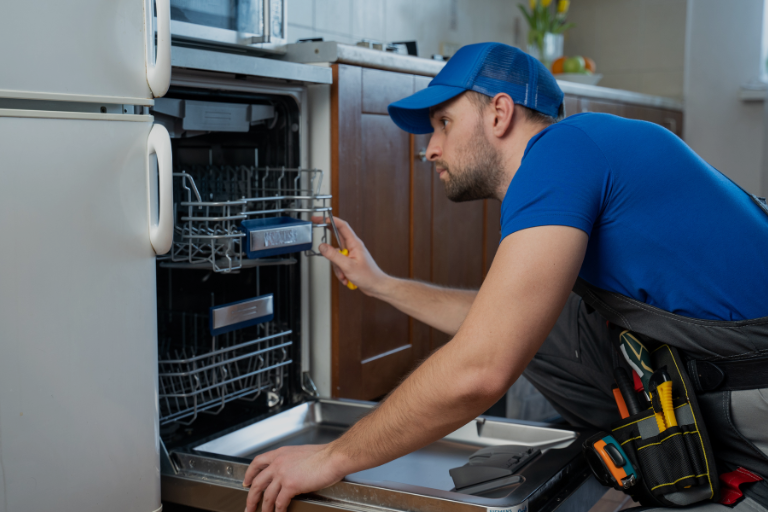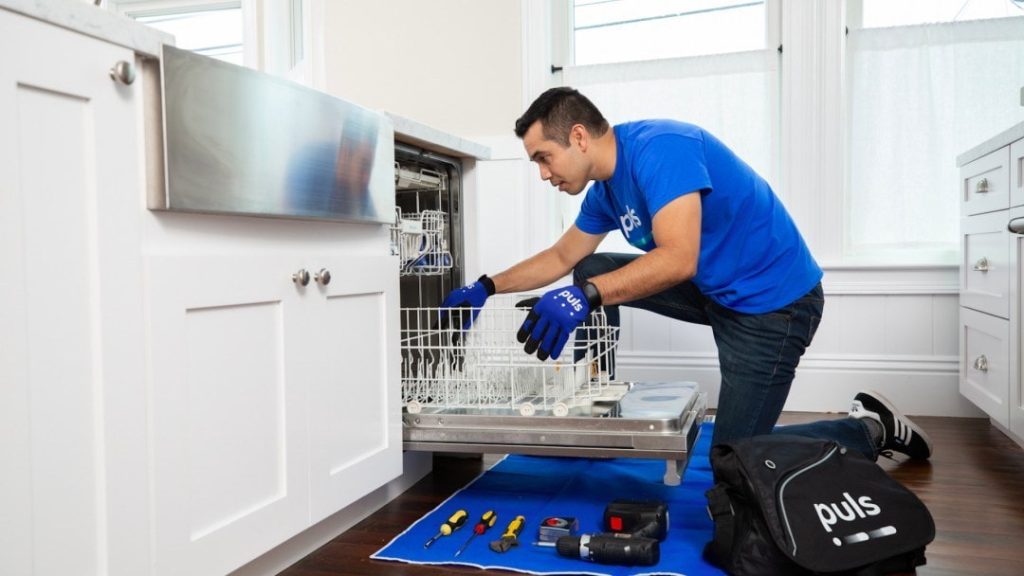How to Fix a Leaky Dishwasher: Step-by-Step Guide

A leaky dishwasher can cause significant disruptions in your kitchen and lead to water damage if left unchecked. Fortunately, identifying and fixing the leak can often be a straightforward process. In this step-by-step guide, we will walk you through the most common causes of dishwasher leaks, such as water pooling, door leakage, and drips from the drain hose. With a bit of basic troubleshooting and the right tools, you can restore your dishwasher’s performance and avoid the need for costly repairs. Let’s dive into the details of fixing a leaky dishwasher.

Identify the Type of Leak in Your Dishwasher
Water Pooling at the Bottom
A leaky dishwasher can often manifest as water pooling at the bottom of the dishwasher tub. This issue is commonly caused by a clogged dishwasher filter, a drain pump problem, or a faulty water inlet valve. If your dishwasher fails to drain properly after the cycle, the excess water can collect at the bottom. Checking the filter for any blockages and inspecting the drain hose for leaks should be your first step in addressing this issue.
Leakage from the Door
Water leakage from the door is another common problem, typically caused by damaged rubber seals or gaskets. If the door seal is compromised, water will escape during the wash cycle. The gasket helps maintain a watertight seal during the cycle, and any visible damage should be addressed immediately. Another possible cause of leakage is incorrect alignment of the door, which can prevent the seal from closing properly.
Drips from the Drain Hose
Leaks from the drain hose can occur if there are loose connections, cracks, or blockages. If you notice water stains around the drain hose or on the dishwasher’s access panel, it may indicate that the hose is leaking. Inspecting the drain hose and ensuring it’s securely connected to the dishwasher and the kitchen sink drain will help prevent further issues.
Check the Door Seals for Damage
Signs of Wear and Tear
The rubber seals or gaskets around your dishwasher door are responsible for preventing water from leaking out. Over time, these seals can become worn, cracked, or damaged by food particles, detergent residue, or daily use. If you notice water pooling on the kitchen floor or any stains around the door, check for visible damage to the gasket. If it’s cracked or torn, it will need to be replaced.
How to Clean and Maintain Door Seals
To extend the life of your door seals, clean them regularly with a damp cloth and soapy water. Use a non-abrasive sponge to gently scrub away any dirt or residue. If the seals appear stiff or cracked, it may be time to replace them to maintain a proper watertight seal. You can find replacement seals at most appliance stores or order them online.
Inspect the Hoses for Leaks
Types of Hoses to Check
There are two primary hoses to check when dealing with a leaky dishwasher: the drain hose and the water supply hose. The drain hose carries wastewater out of the dishwasher, while the water supply hose delivers water to the appliance. Over time, both hoses can develop cracks or become loose, leading to leaks. Examine both hoses for visible damage and ensure all connections are secure.
Tightening Loose Connections
If the hoses are intact but you’re still experiencing leaks, check the connections at both ends. Tighten any loose connections using a wrench or pliers. If the hose connections are too tight, they may crack or become damaged, so use moderate pressure. Once the connections are secure, test the dishwasher to ensure the leak has stopped.
Replacing Damaged Hoses
If the drain hose or water supply hose shows signs of significant damage, you should replace them. Most dishwasher repair tasks are simple to do yourself with the proper tools. Turn off the power and water supply to the dishwasher before removing and replacing the hoses. Be sure to use compatible hoses to ensure a proper fit.
Examine the Dishwasher Filter for Blockages
Removing and Cleaning the Filter
The dishwasher filter is responsible for trapping food debris and detergent residue, ensuring that they don’t clog the drain. Over time, food particles, grease, and soap buildup can cause the filter to become clogged. If you notice water pooling at the bottom of the dishwasher, it’s a good idea to inspect and clean the filter. To do this, remove the dishwasher filter carefully and rinse it under warm water.
Importance of Regular Filter Maintenance
Regular maintenance of your dishwasher filter helps keep the appliance running efficiently and prevents leaks. Clean the filter once a month, or more frequently if you use the dishwasher heavily. Neglecting this simple maintenance step can lead to drainage issues, poor dishwasher performance, and water damage from leaks.
Assess the Spray Arms for Clogs
How to Detach and Clean Spray Arms
Spray arms are responsible for distributing water throughout the dishwasher to clean the dishes. If they become clogged with food particles or mineral deposits, they can cause inefficient cleaning and water leakage. To check for clogs, detach the spray arms by following the manufacturer’s instructions. Once removed, rinse them under warm water and use a soft-bristle brush to clear any obstructions.
Importance of Proper Spray Arm Positioning
After cleaning the spray arms, ensure they are properly reinstalled and aligned. Misaligned or improperly positioned spray arms can cause water to leak or distribute unevenly, leading to poor dishwasher performance. Proper spray arm positioning ensures that water reaches all parts of the dishwasher, allowing for thorough cleaning.
Look for Blockages in the Drain
Common Causes of Drain Blockages
Blockages in the dishwasher drain are another common cause of leaks. These can be caused by food debris, mineral buildup, or detergent residue. If your dishwasher isn’t draining properly, it could result in water pooling or leaks. Common causes of blockages include bits of food stuck in the drain, detergent residue, or even a blocked drain pump.
Step-by-Step Unblocking Techniques
To unblock the drain, start by turning off the dishwasher and removing the bottom rack to access the drain. Use a soft cloth to wipe away any visible debris. If necessary, remove the dishwasher filter and clean it thoroughly. You can also use a small sponge to clear any clogged food particles in the drain. If the blockage is deeper, use a plumber’s snake or a wire to clear the drain hose.
Review Drainage Issues
Ensuring Proper Installation of the Dishwasher
Proper installation is crucial for ensuring the dishwasher drains properly. If your dishwasher is not level, water may pool at the bottom or fail to drain completely. Use a leveling tool to ensure the appliance is properly aligned. If the dishwasher is improperly installed, it can cause water to leak from the door or prevent the drain pump from functioning correctly.
Checking the Home Plumbing Connection
Another potential source of drainage issues is the home plumbing connection. Ensure that the dishwasher drain is correctly connected to the sink drain or garbage disposal. Loose or improperly connected plumbing can cause water to leak from the dishwasher during or after the wash cycle.
Test for Leaks After Repairs
Running a Short Cycle to Check for New Leaks
Once you’ve completed the necessary repairs, run a short cycle to check for any new leaks. Watch for water pooling at the bottom or any signs of leakage around the door or hoses. Check the filters, spray arms, and hoses one last time to ensure everything is secure. This test run will help confirm that the repairs have resolved the issue.
Monitoring for Recurring Issues
If the leak persists after repairs, you may need to investigate further. Sometimes the issue may not be immediately obvious, requiring additional troubleshooting. Keep monitoring for recurring issues and consult a professional appliance repair expert if necessary.
Preventing Future Leaks
Regular Maintenance Practices
Regular maintenance is the key to preventing future leaks. Clean the dishwasher filter, inspect the door seals, and check the hoses for wear and tear every few months. Run a cleaning cycle using dishwasher cleaner or a mixture of baking soda and vinegar to keep the interior free from food residue and mineral buildup.
Schedule for Inspections
Scheduling annual or semi-annual appliance inspections with a professional technician can help identify potential issues before they become major problems. Regular maintenance will ensure that your dishwasher continues to function properly and leak-free.

Why Choose Toronto Refrigeration for Your Dishwasher Repairs?
Toronto Refrigeration offers expert appliance repair services in Toronto and the surrounding areas. Our experienced technicians are skilled in diagnosing and fixing a wide range of dishwasher issues, from minor leaks to complex drainage problems. We provide affordable appliance repair solutions and ensure that your dishwasher runs smoothly after every repair. If you’re facing dishwasher issues that require professional attention, Toronto Refrigeration is here to provide you with top-quality repairs and service.
Conclusion
Fixing a leaky dishwasher doesn’t have to be overwhelming. Following the steps outlined in this guide, you can diagnose and address most issues yourself. From cleaning the dishwasher filter to tightening hoses and replacing damaged seals, simple maintenance practices can help prevent future leaks and extend the life of your appliance. If the issue persists or is too complex, don’t hesitate to contact Toronto Refrigeration for professional appliance repair services. Ensure your dishwasher is always in top shape and free from leaks with regular maintenance and timely repairs. Our expert technicians are equipped with the knowledge and skills to address a wide variety of appliance issues, including Oven Repair and water leaks. Whether you’re dealing with a stubborn leak in your dishwasher or a malfunctioning oven, our team can quickly diagnose and fix the problem. With years of experience in appliance repairs, we ensure your appliances are functioning properly, preventing further damage and costly repairs down the line.